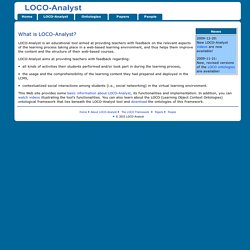

Assign2.pdf. EDUC 5303 Wiki - Learning Analytics. Weebly - Learning Analytics. Google Docs - A2 Speaking Notes. Google Docs - Assignment 2 Outline. Google Slides - Learning Analytics. Google Docs - Learning Analytics. Google Sheets - Learning Analytics - Class Results. Google Docs - Questions from the Class. Institutional-Readiness-for-Analytics-Vol1-No8.pdf. ELI7079.pdf. JISC Inform / Issue 36, Spring 2013. Analytics is defined by Wikipedia as ‘the discovery and communication of meaningful patterns in data’.

The topic keeps climbing higher up the academic agenda as converts in the commercial world demonstrate how it is helping them boost customer satisfaction and improve business efficiency. An example of this can be seen every time you search for something in Google, the search engine uses data it has collected about your interests and previous searches to tailor the ads and information it shows to match what you’re looking for. In the same way, successful online retailers gather data about what we have bought or looked at before and use it to inform their recommendations for what we might like to try next. That’s analytics in action. Why are analytics important? What are the benefits of analysing your data? Benefits include: Organising and analysing research Many universities maintain repositories containing their researchers' publications. How do students feel about it?
OpenLearningAnalytics.pdf. Assignment 2 Notes. a2. Learning analytics. Learning analytics is the measurement, collection, analysis and reporting of data about learners and their contexts, for purposes of understanding and optimising learning and the environments in which it occurs.[1] A related field is educational data mining.

For general audience introductions, see: The Educause Learning Initiative Briefing [2]The Educause Review on Learning analytics [3]And the UNESCO "Learning Analytics Policy Brief" (2012)[4] What is Learning Analytics? [edit] The definition and aims of Learning Analytics are contested. But this definition has been criticised: "I somewhat disagree with this definition - it serves well as an introductory concept if we use analytics as a support structure for existing education models.
A more holistic view than a mere definition is provided by the framework of learning analytics by Greller and Drachsler (2012).[8] It uses a general morphological analysis (GMA) to divide the domain into six "critical dimensions". History[edit] Software[edit] Student Activity Monitor. Introduction To increase self-reflection and awareness among students and for teachers, we developed a tool that allows analysis of student activities with different visualizations.

The following figure shows a screenshot of the start screen of the tool and the different visualizations. Screenshot 1 (see below) demonstrated the main screen with 3 parts. On the top left (box 1) different visualizations are presented. On the top right (box 2), an overview of statistics for the course is selected. Visualizations There are 3 different visualizations: the line chart (box A) (also in Screenshot 2), parallel coordinates (box B) (see Screenshot 3) and the bar chart (box C). Every line in the line chart is one student.
As can be seen, in Screenshot 2 there are many lines, which can be good to see tendencies, but also causes clutter. The parallel coordinates chart is a bit more complex than the line chart. References. LOCO-Analyst. LOCO-Analyst is an educational tool aimed at providing teachers with feedback on the relevant aspects of the learning process taking place in a web-based learning environment, and thus helps them improve the content and the structure of their web-based courses.

LOCO-Analyst aims at providing teachers with feedback regarding: • all kinds of activities their students performed and/or took part in during the learning process, • the usage and the comprehensibility of the learning content they had prepared and deployed in the LCMS, • contextualized social interactions among students (i.e., social networking) in the virtual learning environment. This Web site provides some basic information about LOCO-Analyst, its functionalities and implementation. SNAPP. Learning Analytics and Educational Data Mining in Practice. Penetrating the Fog: Analytics in Learning and Education. George Siemens (gsiemens@gmail.com) is with the Technology Enhanced Knowledge Research Institute at Athabasca University.

Phil Long (longpd@uq.edu.au) is a Professor in the Schools of ITEE and Psychology and is Director of the Centre for Educational Innovation & Technology at the University of Queensland. Comments on this article can be posted to the web via the link at the bottom of this page. Attempts to imagine the future of education often emphasize new technologies—ubiquitous computing devices, flexible classroom designs, and innovative visual displays. The Learning Analytics Workgroup (LAW) Report. Week 1: Introduction to Learning Analytics. Learning Analytics: Welcome to the future of assessment? (EdMedia2014 Keynote)
Intro to Learning Analytics. Learning%20Analytics.pdf.